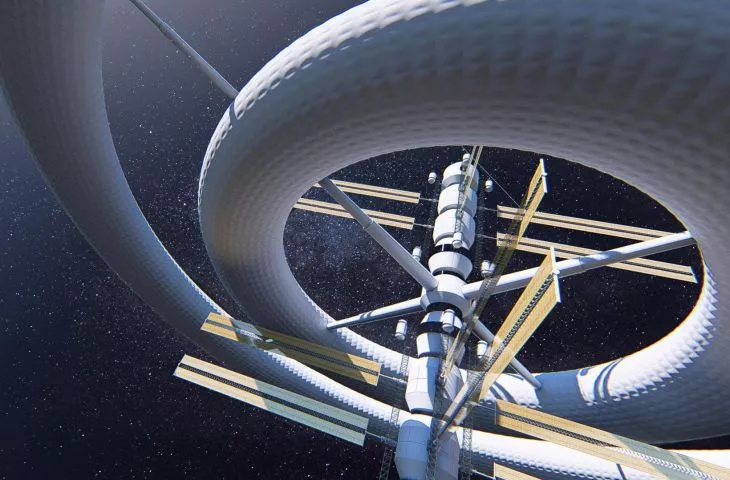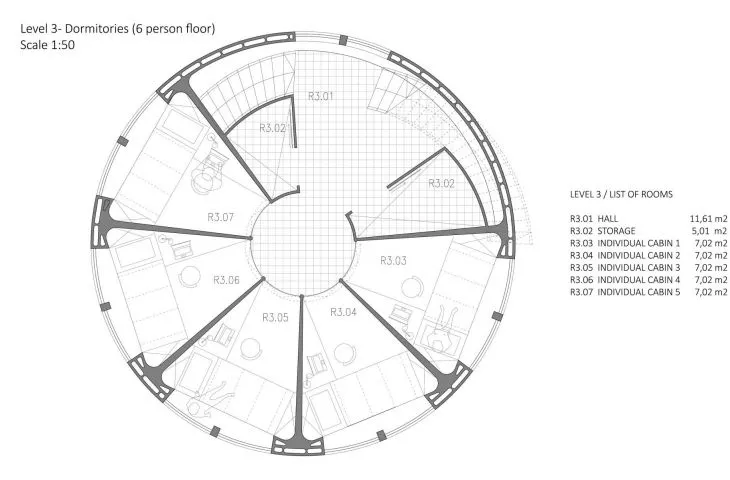The station for two thousand astronauts was designed as the first facility of its kind sent from planet Earth, which will host all future space missions and a stopover station for further space exploration. It was designed as a place to adapt to life in extraterrestrial conditions, to adapt the body to function under different gravitational forces, and, above all, as a place for daily life for a colony of up to ten thousand people.
visualization of the Space Station
© Filip Jakubczak
justification for taking up the topic
The eminent astrophysicist Stephen Hawking said in a 2017 interview that humanity must become an extraterrestrial species if it wants to avoid self-destruction, giving our planet a hundred years to die out. At the moment, the Earth is struggling with many problems of civilization and more and more cataclysms, which in the future may bring even more consequences, such as poisoning the atmosphere or depleting drinking water supplies.
All people - especially architects and designers - should push the boundaries of comfort in their projects and show how humanity can cope with the coming problems.
This is why the design of an expandable Space Station for two thousand astronauts was created. The facility, which is not physically connected to any planet, is designed to achieve resource and functional self-sufficiency - introducing the latest environmental and technological solutions into the daily lives of its inhabitants. The station should serve as a halfway house on the road to further exploration of the solar system's planets.
A model of the Space Station and an expansion diagram
© Filip Jakubczak
characteristics of the facility
The proposed station is a large-scale space facility hosting permanent crew members. In addition to its living and research function, the facility can serve as a docking station for accompanying facilities and an intermediate station for the exploration of Solar System planets. For the comfort and safety of life, rotational forces act on the station, giving the effect of artificial gravity (the so-called Coriolis force).
A cross-section showing the actions of the Coriolis force and a functional cross-section
© Filip Jakubczak
The facility was designed to strive for sustainable growth and expansion and to meet the objectives of:
- provide all conditions for a permanent population;
- produce supplies and give the possibility of processing them;
- provide a transportation system for people, materials, energy;
- develop commercial activities to create interdependence between the station and the Earth.
location
The facility is located in geosynchronous extraterrestrial orbit to provide the best data transmission and logistics capabilities. The station is thirty-six thousand kilometers from Earth (ten percent of the distance between Earth and the Moon), so that correlation takes place between Earth and the station and the station and the Moon.
design assumptions
Within the station, living, spatial and environmental conditions are provided for the simultaneous residence of a colony of two thousand people. Safety is provided by an external isolation membrane and a multi-stage form of emergency evacuation.
cross section
© Filip Jakubczak
The interior of the facility takes the form of a triaxial city with a distanced part responsible for vegetation and transferring the main loads. The internal living structures take the form of tapering "legs," taking advantage of the structural possibilities of organic 3D printing and variable gravitational forces.
The functions inside the "legs" are arranged in such a way as to provide for all forms of urbanist interactions of residents: unavoidable, optional and social. The residential function has been located in the lowest part, so that it is also affected by earth-like gravitational forces.
projection of the dormitories (3rd floor).
© Filip Jakubczak
conclusion
The Station's design has been created taking into account the latest technological possibilities, respecting the culture and targeting its potential users, Generation Y. The design solutions used ergonomically provide humane and psychologically favorable conditions for permanent residence, create the possibility of the existence of an intermediate station for deeper space exploration and the possibility of a preparatory base for life in other extraterrestrial environments.
The project is a bold prediction of life that could be a daily reality for many of us, thrust into the stars by the specter of global catastrophe. As Stanislaw Lem's work has proven to us many times before, some cosmic predictions, come true faster than we would think.
Filip JAKUBCZAK
© Author























































































